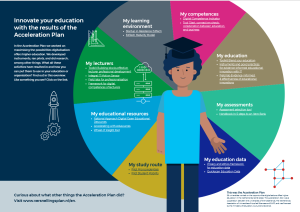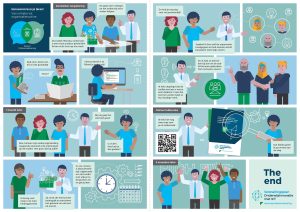
Infographic results Acceleration Plan
In the Acceleration Plan we worked on maximising the possibilities digitalisation offers higher education. We developed instruments, ran pilots, and


The hail is falling against the windows whenBram Enning and Nico Boot talk online about their ambitions, challenges and opportunities within the Acceleration Plan. Bram is policy advisor Institutional Research at Leiden University of Applied Sciencesand since the beginning of 2021 the new team leader of the zoneSecure and reliable use of learning analytics.. Nico is advisor digitalisation at the faculty Science & Technology of Hogeschool Leiden. Since the beginning of 2021, he is the new team leader of the zone Evidence-informed educational innovation with IT.. Read more about the zones and Bram and Nico in the double interview.
Nico:“So we are the two leaders of a relatively small university of applied sciences within a very large Acceleration Plan.”
Bram: “How a small university of applied sciences can grow in such a subject.”
Nico:“This also speaks of ambition. Ten years ago, we were lagging behind in terms of IT. And we wanted to take big steps in that area. That is happening now. Look at the institutional plan and the ambitions expressed in the participation in four different zones within the Acceleration Plan.”
It’s about innovation – trying out new things to get the story out of that data
Nico: “And Bram, what makes study data so much fun for you that you think, I’ll take the lead in this?”
Bram:“I’ve always been working with innovation. During my PhD and postdoc trajectory (in the field of the history of psychology), I worked – even before digital humanities had become a theme – with databases, Python and online tools for my research. When I joined Studiekeuze123, I was the driving force behind the innovation of technology there, and in Leiden I was able to build a team around this subject. Participation in the Acceleration Plan was therefore a logical step. For me, it’s all about innovation, trying out new things to get the story out of the data. A failure rate of 30%, what does that tell you? I continue to find that a very fascinating and also difficult question.”
Nico:“And the drop-out rate brings us back to the human aspect. That is also a piece of psychology.”
Bram:“I think you’re referring to how students feel, how things are going with our students. How do we measure that? How do we measure that? It remains a challenge. It may be impossible in principle, but it is always an approximation. Education data is helping more and more, because there is more of it, more diverse data is being created and it is easier to access. In addition, instructors, managers, directors, students and administrators also expect more from data and the insights it can provide.”
Nico, how do you actually see it, is the evidence-informed zone only about data, or are there other forms of evidence as well?”
Nico: “If you have an idea of how you want to design education, you start looking. Is it something that has already been done at your own or another institution? Is there information about it? These are all sources that we try to use to come up with new education. Evidence is a broad term. It is education data, scientific knowledge about learning and scientific knowledge about teaching methodology. In fact, we should use all this information on a structural basis when innovating our education. Based on an analysis of this, you can determine the direction.”
Bram: “That sounds like a working method you can use when shaping your education. That is a task for the institution, or perhaps study programmes. Do you already have an idea of how your zone can be of importance in that respect?”
Nico: “I like what you said. Because one of the important elements that we see in evidence-informed working is the use of a validated process model. The fact that you consciously and structurally go through a (cyclical) process, that should be the starting point. For example, we use the ADDIE model as a basis for the good practices and instruments that are made available from the zone. So what we hope to achieve is that educational institutions can facilitate, support and/or strengthen a culture of evidence-informed working.”
Stimulating, facilitating and strengthening evidence-informed working is a challenge
Bram: “So if I understand you correctly, an important component, perhaps the most important component within your zone, is involving people within the institutions who shape that education?”
Nico: “Yes, we very deliberately focus on the people who facilitate the educational development process in a very broad sense within an institution. This includes educationalists and educational support staff, for instance. We hope to reach these people and offer them tools. To stimulate, facilitate, or reinforce awareness of what evidence-informed working entails and why it is important at various levels within an institution. That is a challenge.”
Bram: “That certainly is a challenge. In our zone, we work with eight different roles, which we all approach in a different way.”
Nico:“You have made a great website for that.”
Bram:“That is right. On our website www.doe-meer-met-studiedata.nl all those target groups (including students, teachers, directors and administrators) can find information that is specifically applicable to them.
Something that is relevant to all of them is the national Privacy and Ethics Reference Framework. The framework provides a national frame for the secure and reliable use of education data. It describes the underlying values and principles that all institutions apply when using this data (think of equality, honesty and inclusiveness). That also translates into the way we deal with education data, and how we can be transparent about it.”
Nico: “Sounds like something that is very important for higher education. To show how we can deal with data together. Because there are questions, such as: who is allowed to see something? Who owns the data? How do we deal with this?”
Bram: “The framework should help to answer these questions. It does not prescribe what to do, but rather gives direction. The starting point is to be open about what we do and do not want. How do we use study data in such a way that it fits in with our values as a higher education institution? These are complex questions, which we are mapping out together with students, researchers, administrators and experts.”
Nico:“What triggers me about your answer is that something similar happens in my zone. We try to come up with solutions for every higher education institution, but at the same time we know it does not exactly work that way.
Take the interviews and good practicesfrom our zone. They reveal those elements that recur everywhere, but one definition of evidence-informed working would be inadequate. So we try to provide tools that fit into as many identities as possible, but you have to explore for yourself how you can apply this value in your institution.”
The movement is situated on a local level, within the institution
Bram:“That is, of course, the complicated part of the Acceleration Plan. You try to get something moving nationally, but the movement is situated on a local level, within the institution. These have different gears, the power differs per engine, some drive mainly on the motorway, others need an off-road vehicle. You look for the greatest common denominators, but not all products are equally relevant to all institutions.
This brings me to the question: do you also form communities?
Nico: “We have interviewed the institutions in our zone about how they shape and implement evidence-informed working. We shared the results with the community for the first time last February during an inspiration session. The idea is to organise another session this autumn, in order to encourage active and sustainable sharing of knowledge. We want to do a lot with this. We are just looking for a form that will also be sustainable after the Acceleration Plan.”
Nico: “And what will you have achieved in two years?”
Bram: “That working with education data is seen as normal in more areas of education. Once the notion has sunk in, that working with data requires a joint effort on the part of an institution, sometimes even on the part of the sector as a whole, then we achieved something beautiful. The Frame of Reference, the Statistical Manual for Study Data (Statistisch Handboek Studiedata) and the training course we are developing will help to achieve this.”
Nico: “And of course, what is important is that IT should always serve education. It is always the tooling, a means and never the end.”
Photo by Michal Czyz via Unsplash
Share this page

In the Acceleration Plan we worked on maximising the possibilities digitalisation offers higher education. We developed instruments, ran pilots, and

Educational innovation using ICT has been a priority in higher education for years, due to its impact on the quality

Getting started with the (continued) development of a powerful learning community How can collaboration between companies and educational institutions be

The field of education is constantly evolving. Students require dynamic, relevant content, while lecturers aim to optimise their teaching, making